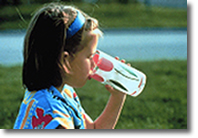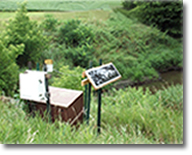

The
Minnesota River, its tributaries, and the lakes within its drainage basin
are prime natural resources for the State of Minnesota and for residents
living within the watershed.
They offer beautiful scenery, a bountiful population of migratory waterfowl,
habitat for wildlife, and opportunities for fishing and boating. In addition,
surface water and groundwater aquifers provide drinking water for several
communities and many rural residents.
What are the water quality problems in the
watershed?
Unfortunately, these benefits are limited by poor water quality.
Bacteria and other pathogens make river water unsafe for drinking and activities that involve skin contact or the chance of swallowing the water because these organisms can cause disease.
Sedimentation
restricts the areas where fish can spawn, limits biological diversity,
and clouds river water, jeopardizing the growth of healthy plant life
rooted in the riverbed.
Phosphorus excesses trigger the growth of large populations of
algae. High rates of algae growth can severely deplete the supply of oxygen
(creating hypoxia) in the river and endanger fish and other kinds of aquatic
life. This is especially true during times of low flow, in slow-flowing
areas such as reservoirs and the lower reaches of the Minnesota River.
Nitrate-Nitrogen in the Minnesota River endangers drinking
water because the river recharges drinking water aquifers in the area.
For example, the City of St. Peter’s shallow aquifer is contaminated
with nitrates and poses special health concerns for people who use it
as a drinking water supply.
Hydrologic
modification, in addition to water quality, also is a concern
that limits the beneficial uses of rivers and streams within the Minnesota
River Basin. Chronic annual floods cut down and widen streams, erode stream
banks, damage property, and place severe stress on communities and residents
of the floodplain. Typically, landowners downstream are prone to economic
loss from drainage practices upstream.
What
are the effects downstream from the Minnesota River?
Poor water quality in the Minnesota River Basin contributes to problems
experienced further downstream. One example is the problem of excessive
algae growth in Lake Pepin, which is particularly severe in dry, low-flow
years. Phosphorus discharged from the Minnesota into the Mississippi River
has been identified as a significant source of Lake Pepin's problem.
Even further downstream, where the Mississippi River enters the Gulf of
Mexico, excess nitrogen from the Mississippi has been identified as contributing
to high rates of algae growth and subsequent oxygen depletion. The Minnesota
River has been identified as one of several relatively high contributors
of nitrogen to the Mississippi River. Thus, the Minnesota may be at least
partially responsible for this large-scale problem.
Text courtesy of Minnesota Pollution Control Agency (MPCA)
http://www.pca.state.mn.us/water/basins/mnriver/
For
More Information
United States Geological Survey's Primer on Water Quality
http://water.usgs.gov/pubs/fs/fs-027-01/index.html
MPCA's Minnesota's
Impaired Waters and TMDLs
http://www.pca.state.mn.us/water/tmdl/index.html

| landowners | educators | site map |
Brown Nicollet Cottonwood Water Quality Board
322 South Minnesota Avenue | St. Peter, MN 56082 | Phone: 507-934-4140 | Fax: 507-934-8958